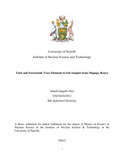| dc.description.abstract | In plant nutrition soil micronutrient concentration is classified into two; total and
extractable portion. The total concentration is not related to that potentially available to
plants but is used to indicate the relative abundance and potential replenishing power of a
particular element in a soil. The extractable/soluble portion is the concentration as
indicated by extraction methods like ammonium acetate ethylene diamine tetra-acetic
acid (AAAc-EDTA) and are usually considered as plant available. Although soluble
concentrations are crucial in plant nutrition, the extraction procedures involved often
require the use of a sizeable amount of chemical reagents and are time consuming. Total
concentrations of Mn, Fe, Ni, Cu and Zn in soil samples from Muguga were determined
using Total X-Ray Fluorescence Spectroscopy (TXRF) technique while Inductively
Coupled Plasma Optical Emission Spectroscopy (ICP-OES) was used for investigating
their extractable concentration. A relation between total and extractable could mean
adoption of quick, fairly nondestructive spectral methods like TXRF instead of
conventional wet chemistry methods like AAAc-EDTA. Topsoil pH, topsoil carbon and
variation of total elemental concentration with depth were also investigated. The soil
TXRF spectra was also deconvoluted using Picofox inbuilt software and later using
qualitative X-ray analysis system (QXAS) software package.
The Pearson‟s correlations between the extracted and total concentrations were 0.90 for
Ni, 0.80 for Zn, 0.59 for Mn, 0.57 for Cu and - 0.33 for Fe. The extracted amount and pH
had r values of 0.59 for Mn, 0.58 for Cu, 0.42 for Fe, 0.40 for Zn, 0.15 for Ni while that
of the extracted portion and carbon were 0.76 for Zn, 0.74 for Mn, 0.66 for Ni, 0.36 for
Cu and 0.09 for Fe. Topsoil to subsoil Fe, Mn, Zn, Cu and Ni concentrations had r value
of 0.87, 0.79, 0.74, 0.50 and 0.32 respectively. Copper was the only nutrient in
sufficiency range while Mn and Zn were in excess. The samples were strongly acidic
with an average pH of 5.4 which could have resulted in the high solubility of the
micronutrients. Acid tolerant crops should be grown and the farmers should also lime
their farms and use nitrate nitrogen fertilizers and avoid ammoniacal nitrogen fertilizers.
The Picofox inbuilt and QXAS software did not agree on a single measurement when
quantifying Fe, Mn, Zn and Cu spectra, however the two methods showed some
agreements when quantifying Ni spectra. Studies involving at least a few reference soil
spectra is recommended to decide on the better method of the two. The strong relation (α
= 0.05) between total and extractable concentration for Ni, Zn, Mn and Cu means total
element concentration in soil could be used as an indicator of their extractable amounts.
However, studies involving different regional soils, associated plants and different
extraction reagents is recommended to select the most appropriate extraction method. | en_US |

